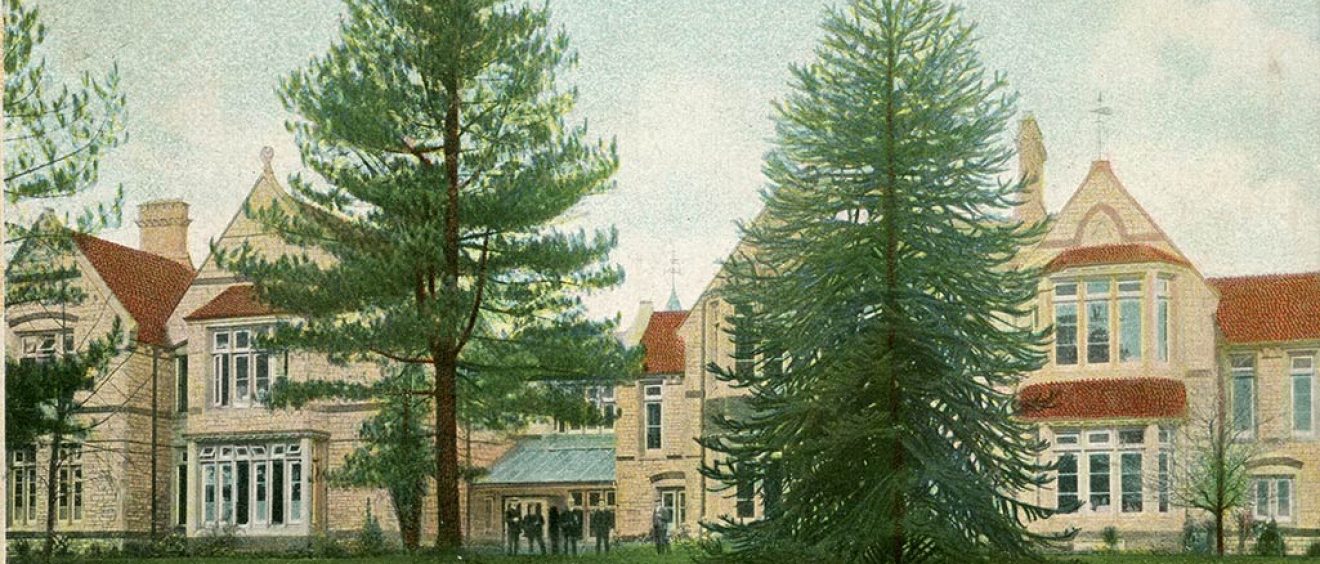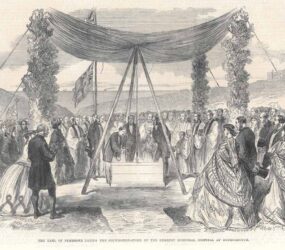
Herbert Convalescent Home
The Herbert Convalescent Home was built in the memory of Lord Herbert (Sidney, 1st Baron Herbert of Lea born in 1810. He was the second son of George Augustus, 11th Earl of Pembroke. As well as President of Salisbury General Infirmary (1842-1861), he was Secretary of State for War during the Crimean War. He was also close friend to Florence Nightingale who’s legendary status in nursing was formed when Herbert helped her gain position in the hospitals at Crimea.
After a short illness Herbert died 2nd August 1861 at Wilton House. A month later on September 26th 1861 a meeting was held at the Council House in Salisbury and the Herbert Memorial Committee was established to honour the memory of Lord Herbert. It was decided to erect a statue in the Market Place and to build a convalescent home near to Bournemouth on the model of the earlier one founded by him in Charmouth, Dorset.
The statue was designed and made by Baron Carlo Marochetti (1805–67) who’s work included commissions of Queen Victoria and Prince Albert as well as engineering notables such as Robert Stephenson and Isambard Kingdom Brunel. Herbert is depicted in everyday clothes, rather than ceremonial costume, this effect was used to ‘produce an impression of his real figure and look and presence, than a more ornamental statue arrayed in robes.’ Held in his right hand is a paper scroll that has an engraved plan of the Herbert Convalescent Home. Accounts from the time shows that the cost of the statue as £2021 18s 10d. Herbert’s statue was unveiled to the public in the summer as this photograph in the 1922 book History of Salisbury Infirmary Book positioned in the Market Square. It was later re-sited to Victoria Park in Salisbury.
Seaside home
In 1865 land at 49 Alumhurst Road, Westbourne was purchased and the home was built and run by the Salisbury Infirmary.
Described as: ‘Built on a noble site facing the sea, upon a sandy cliff, where the patients will possess the advantage of pure and healthy air, the quiet of the countryside and the convenience of a town close at hand.’ ‘The design of the building was furnished by a lady who was specially qualified to form a judgement of the best mode of treating the sick and whose fond regard for Lord Herbert induced her care to this subject, even in the hours of suffering. In this design of Miss (Florence) Nightingale, the arrangements, instead of being concentrated in one block, as is the case generally in hospitals, provide for the patients in detached wings, joined to the centre building by corridors’. (Extract from book The History of Salisbury Infirmary 1922)
The work was carried out under Thomas Henry Wyatt who was a prolific architect working on numerous Wiltshire churches and national public buildings, he later became President of RIBA (Royal Institute of British Architects) He too worked ‘as a grateful token of the personal devotion to the memory of Lord Herbert’. The first stone was laid on Saturday 16th September 1865 by the young Earl of Pembroke (13th) under the guidance of his mother.
An article from the Illustrated London News, 30th September 1865 describes the event of the foundation of the Herbert Home. ‘A special train from Wilton, bringing Lady Herbert and her son, the youthful Earl, stopped on its way at Salisbury, Romsey and Ringwood, taking up many of the visitors, who, on arriving at Christchurch, went on by various conveyances to Bournemouth. Here they were met by a local procession headed by the clergy and choir of St Peter’s Church who sang the 103rd Psalm’
Lord Pembroke who was fifteen years of age, performed the ceremony of laying of the stone. He stated ‘A better or more fitting memorial could not have been chosen than this, which is for the relief of the sick poor; for all my father’s life was spent in relieving suffering. To-day is the anniversary of his birthday, and therefore a very fit time to begin such work.’
After prayers and singing of the 127th Psalm the crowd moved off to the Cranborne Pleasure Grounds where a lunch was provided in a large tent. Lady Herbert also wanted to bestow a gift to the project and donated to pay for a clock and tower at the main entrance. Described as ‘not only a very handsome ornamental addition to the appearance of the buildings, but a very useful timekeeper’ The words “Herbert Home” with the date were also carved into the front entrance. Accounts show that the Home, including land purchase, buildings and furniture £5838 17s 11d
Life in the home
From the Rules and Regulations of the home
1. As to the Admission of Convalescents: The home is intended solely for the reception of Convalescents already in course of amendment, and cases cannot be accepted unless the Committee has fair reason to believe that health will be re-established or greatly improved by the change of air, rest and simple diet of the home. ‘Quiet, cleanliness and decorum must be strictly observed at all times’
Other rules to abide by were:
• Drinking alcohol and gambling were strictly forbidden
• Smoking was at the discretion of Matron
• Visitors were allowed between 2-4pm
• Stout shoes for exercise
• Slippers needed for indoors
• All clothing needed to be marked for the laundress
• Convalescents had to make their own beds and take daily exercise….
A postcard in our collection show the front of the convalescent home, the reverse tells us more details about staying there. Signed Fred, he writes: Comfortable board and lodgings. 8/- for the time. Bournemouth very cold tonight. Been to the sad (?) sea waves. Dated 3rd July 1909 and posted back home to Gigant Street, Salisbury.
By the formation of the National Health Service in 1948 it had been renamed the Herbert Sanatorium and was run by Bournemouth Borough. Present day the home is now called Nightingale House and used as a community hospital for care and treatment of mental health patients. The surrounding streets have all have familiar names too: Herbert Road, Pembroke Road & Groveley Road.















